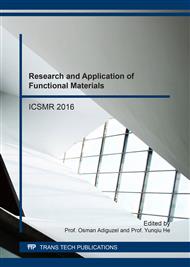p.101
p.105
p.110
p.116
p.121
p.127
p.133
p.137
p.141
Optimization Process during Laser Machining of 2 mm Thick Al/Al2O3 MMC
Abstract:
It is very difficult to machined Al/Al2O3-MMC by Laser as the heat conductivity of this material is very high [1]. This research paper presents experimental study of machining parameters Optimization [2-8] during machining of 2 mm thick Al/Al2O3-MMC. Response surface methodology (RSM) is used to achieve optimization i.e. minimum hole tapering and maximum Material Removal Rate (MRR). Design of Experiment software is used for optimization by RSM method [9-10]. In this experimental set up 1kW ytterbium Fiber Laser machine is used. Fig 4 shows SEM photograph of a drilled hole generated by Ytterbium fiber laser machining of Al/Al2O3 MMC workpiece. It is an experimental result, obtained during laser beam machining at 750 Watt laser power, 700 Hz modulation frequency, 15 bar N2 gas pressure, 0.30s wait time and 70 % pulse width. The shape of the generated hole is round and derbies are found along the periphery and inside the wall of the generated hole. From Fig. 4, it is clear that the difference between the maximum and minimum average diameter of the hole at the opening is very low. The vaporized material overflows at the drilling spot, it is due to supply of high laser power. From Fig 4, it is also clear that the maximum diameter of the hole is 1.008 mm and minimum hole diameter is 1.003 mm. This hole is almost perfect round hole as only 5 μm deviation is observed on diameter at the openings of the generated hole. From table 5 and 6 it is clear that the error during calculation of MRR and taper is very less. For MRR, the difference between actiul value and calculated value from equation 2 is 0.003 g/s and similarly for taper the difference between actiul value and calculated value from equation 3 is 2x10-4rad.
Info:
Periodical:
Pages:
121-126
Citation:
Online since:
July 2017
Authors:
Price:
Сopyright:
© 2017 Trans Tech Publications Ltd. All Rights Reserved
Share:
Citation:


